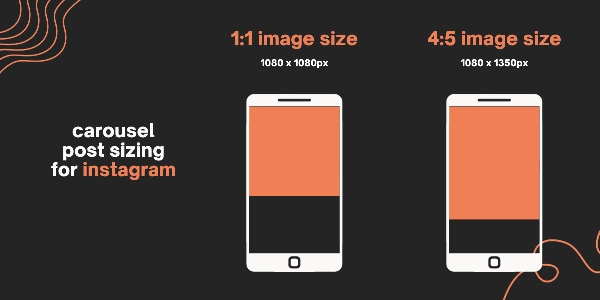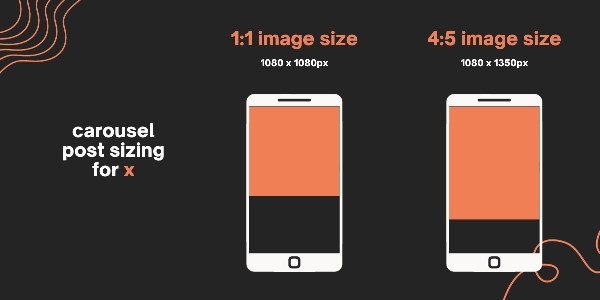Carousel posts on social media are essentially slideshows. They allow you to include multiple images or videos in a single post, all topped off with a nice cover slide. Because of this, they’re a unique tool for marketers and brands looking to capture attention, sell products, or tell a brand story.
In this guide, we’ll explore tips and tricks on how to create effective carousel posts on Instagram, LinkedIn, X (FKA Twitter), and Facebook.
We’ll also dive into the benefits of carousel posts, as well as why you should make them a key part of your marketing strategy. Keep reading to learn more!
Why Use Carousel Posts?
Before we look at the quirks of carousel posts on each social media platform, let’s look at why you should be using them. We’ve broken down the primary benefits of carousel posts into three sections: captivating attention, increasing dwell time, and enhanced interaction.
Check out below for a full explanation of each:
Grabbing Audience Attention
Carousel posts allow brands to tell a compelling story or showcase a product/service in a sequence of images and/or videos. According to Hootsuite, carousel posts on Instagram have been shown to generate engagement that is 3.1 times higher compared to regular posts.
It should be noted that Instagram, as well as the other platforms mentioned in this guide, is constantly changing its algorithm. At the time of writing, carousels receive more engagement than regular posts, but that may not be the case when you’re reading. Be sure to check the latest news regarding this.
Increased Dwell Time
Users tend to spend more time engaging with carousel posts as they swipe through each slide. Naturally, there’s more content in a carousel post when compared to a regular post, so it makes sense that readers would spend more time viewing carousels.
This increased dwell time can significantly impact brand awareness and message retention. Additionally, social media platforms will see people spending more time looking at a carousel post, and mark it as engaging. This algorithmic boost can be hugely beneficial for reaching a broader audience.
Enhanced User Interaction
Carousel posts encourage users to actively engage with content, fostering a sense of participation. On Facebook, we’ve seen many, many times that posts with multiple images or creatives often receive more interactions than others.
By including multiple images in your posts, you’re giving your brand the best possible chance of receiving more interactions and engagement on platforms like Facebook and Instagram. It should be noted that for brand perception, video content is often the best option.
Creating Carousel Posts for Different Social Networks
Every social network will have different quirks and requirements for the content posted to the platform. This ranges from sizing requirements, limitations on media, as well as how many individual images (or slides) you can include in a single post.
In this section, we’ll look at the carousel post requirement for Instagram, LinkedIn, Facebook, and finally X (FKA Twitter).
Carousels on Instagram
Size: 1080 x 1080 pixels or 1080 x 1350 pixels.

Instagram is the platform in which you have the most freedom when it comes to carousel posts. You’re able to include up to ten different slides within a single carousel, which can be a mixture of images, video, and animations.
Images need to be in JPEG or PNG format, and no larger than 30MB in size. Videos should be 60 seconds long or less, and in MP4 format with a maximum size of 4GB. You can either create them directly in the app on your phone, schedule them through Meta’s Business Suite, or even via a third-party tool like Sprout Social.
Something to keep in mind with Instagram is that carousel posts will get shown to your audience twice. The first time, they’ll see the cover slide. If they scroll past without interacting, they’ll then be shown the post again, this time with the second slide visible.
This double exposure means you have twice the chance to hook your audience. So when creating carousels for Instagram, be sure to make both the first and second slides enticing.
Carousels for LinkedIn
Size: 1200 x 1200 pixels.

Unlike Instagram, on LinkedIn, you’re only able to include static images in your carousels. And this is for one key reason… carousels on LinkedIn must be uploaded as either PDF, PowerPoint or DOC files. Whilst this is a limitation, there’s one aspect where LinkedIn trumps Instagram, and this is the slide limit.
On LinkedIn, when uploading a carousel, you have a limit of a whopping 300 pages to play with. Plus, you’ve got a generous file size limit of 100MB.
Something else to note with LinkedIn is that whilst the platform will allow you to upload individual image files, doing it this way won’t display them as a carousel that the user can swipe through. Instead, they’ll upload as a collection of images, much like how Facebook does the same thing.
Carousels on Facebook
Size: 1080 x 1080 pixels.

Facebook is an interesting platform in that it does allow carousels, but not as native, organic posts. Instead, the only way that you can publish a carousel onto the Meta-owned social network is via an ad.
The limitation here is that to make use of carousels on Facebook, you have to spend money. There’s simply no way around this. Furthermore, your existing audience won’t see the carousel organically, as you’ll need to define audience targeting when setting up your required ad.
Carousels on X (FKA Twitter)
Size: 1080 x 1080 pixels or 1080 x 1350 pixels.

Like LinkedIn, when uploading a collection of images to X, they won’t display as a carousel post, but rather a collection of images all displayed together. Additionally, there’s a further limitation to Twitter: you’re unable to include any more than four images in a single post.
You can, however, upload four images to a tweet, then reply to that tweet with four more, and so on. Doing this is known as creating a thread (not to be confused with Threads, the Meta-owned social network), however it’s far from an ideal solution.
Optimising Carousel Posts for Social Media
Now that we’ve seen the requirements for carousel posts on Instagram, LinkedIn, Facebook, and X, it’s time to explore some tips and tricks to help you create carousels.
Here, we’ll explore the importance of using a mix of media, applying consistent and on-brand styling, as well as creating seamless designs for your carousels.
Use a Mix of Media
On platforms that allow it, such as Instagram, Facebook, and X, you should look to combine multiple forms of media in your carousels to ensure they’re engaging. Combine images, videos, and graphics to add variety and keep the audience interested.
You don’t have to include a video specifically, either. Using animated slides to highlight certain aspects of your content can be an excellent way of adding a dynamic spin to your carousel posts.
Consistent Branding
Because of the very nature of carousels receiving more engagement and reach than other forms of content, there’s a good chance that your carousel posts will reach a new audience that isn’t already familiar with your business. This makes it all the more important that your carousel posts are on brand and maintain the same visual style as the rest of your business.
So make sure, when creating carousels – whether they’re just images or a mix of media – to use the same fonts, colours and graphical elements that are already being used across your brand. Remember that with the expanded reach of carousel posts, everything you post is a chance to boost the brand recognition of your business.
Seamless Designs
 Before
Before
 After
After
If you’re proficient with tools like Adobe Photoshop and using Artboards, you can take your carousels to new levels by creating seamless slides. Doing this will allow your audience to scroll through each slide as though it were a single, continuous image.
The benefit is that this creates an experience that feels unique, something that will endear readers to your brand. If you don’t have the Photoshop skills required, a similar effect can be achieved using free tools such as Canva.
Simply create a canvas that’s the same width as all the slides together (4320px for four slides that are 1080px in width, for example) and create a design that ignores the slide breaks. Once you’re happy, you can then use another free tool like Postcron’s Image Splitter to cut up the full image into however many slides you require.
conclusion
Social media platforms continue to evolve and change. Sometimes carousel posts are the best way of getting engagement, and sometimes they’re not. But something that doesn’t change is the versatility of carousel posts.
By making use of carousels in your social media strategy, you can help your business reach a new audience, whilst also creating content that’s both visually appealing and on brand.
Now, as you begin creating carousel posts for your brand, it’s important to ensure that the graphics you’re developing are accessible to all. Our detailed guide on accessibility on social media explains exactly how to do this!






